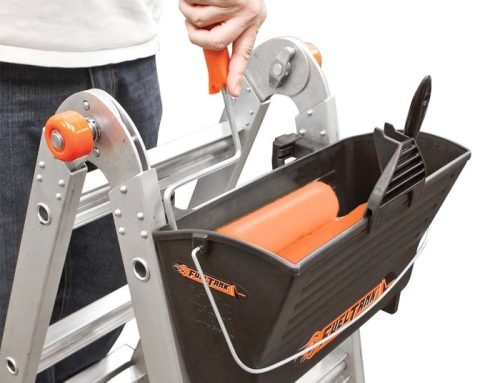The May bank holidays are traditionally a chance to get some spring cleaning done inside and out, getting your home and garden ready for a summer of barbecues, house guests and jollity. With two bank holidays in the same month there is a great opportunity to start a lengthy job like redecorating an entire room or tiling a bathroom where the prep work takes almost as long as the job itself. For all these jobs and more a ladder is a vital piece of equipment, so it's important you check it over for safety's sake before using it, or your long weekend might be ruined.
This ladder safety checklist is in two parts, one for checking ladders before you use them, and one for checking the ladder while it is in use – even with the most stringent planning things can go wrong on the job.
Before you use the ladder:
- Check you are using the best ladder for the job. Step ladders are great, but for painting they can be tricky to use as you often have to stand side-on to the wall to get close enough. This can be dangerous as your balance will be affected, not to mention the muscular fatigue you will experience if you're twisted to one side for hours at a time. Painting trestles may be better, or if you have a tall relative why not use their height advantage to reach the tops of the wall?
- Once you have selected the right ladder ensure it is fit for purpose (if you're unsure, check out the selection on our website. We have examples of every available ladder including specialist ones, so if it's not on our website it probably doesn't exist).
- Check the stiles (ladder sides) for any signs of damage, including dents or broken parts. Also check for oil or other greasy substances and clean this off before using the ladder. If the stiles are damaged there is a high chance the ladder will break while you are on it, so you should get a new ladder (or borrow one from a neighbour).
- Check the rungs of the ladder for damage or grease. Again, clean off any oily residues before using the ladder, and if the rungs are damaged don't use it, get a new ladder. It might be tempting to skip over a broken rung and carry on regardless, but this makes climbing the ladder dangerous, and there's a good chance you'll forget on the descent and crash right through a broken rung.
- Check that any moving parts are moving freely, including hinges, locking brackets and other safety features.
- Check that any fixed parts aren't moving freely, including locking brackets, platforms and handrails.
- Check that safety features work, such as clips on telescopic ladders, braces and stabilising bars and that the ladder feet are firmly secured to the ladder and not oily or dirty.
- Check the area you are working in. Is the ground wet or slippery (inside and out)? Is the floor surface one which affords a lot of grip or not? Be cautious with decking, tiles, carpet and polished wooden floors. Laminate flooring and linoleum can also be very slippery depending on the finish. Are there loose rugs on the floor? Ensure the ground is free from ice, leaves, loose material and oil before setting up the ladder.
- If there are unavoidable issues with the ground surface, consider using a ladder stopper or other safety accessory to keep the base stable while you are using the ladder.
- Check yourself for any loose clothing that could get caught, and ensure you are wearing sturdy shoes which will not slip off. Check your muscles and joints are working well and avoid using a ladder if you are experiencing any muscular or joint pain, as this can lead to accidents and worsening of symptoms. If you are ill, sleep deprived or still recovering from a late night partying session you are less likely to make good decisions, so avoid using ladders in these conditions
Join us for part two soon, where we cover what to check while you are using the ladder.






Leave A Comment
You must be logged in to post a comment.